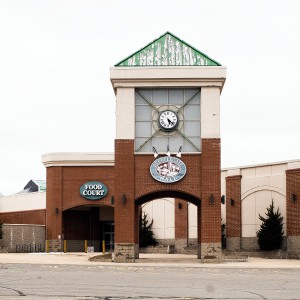Flood of emotions: Faulty culvert causes serious damage to Loudon home
|
Published: 01-14-2024 11:00 AM
Modified: 01-16-2024 12:11 PM |
For weeks, in order to reach her two chicken coops in her backyard, Tessa Dyer put on chest waders. At its worst, the water that had flooded her property surpassed her waist. On a good day, it was still knee-deep.
As temperatures dropped, her flooded property in Loudon became a sheet of thin ice – with a wrong step, she’d crash through, as she did one morning in December when she landed face-first in the icy cold water.
“That was horrendous,” she said. “What a way to start your morning every day and end it every night.”
At first glance, the ice has leveled her yard. But a closer look reveals that the ice conceals two feet of water underneath. Drowned in the pool are remnants of her driveway, garden, fire pit and chicken coops.
For two years, water has accumulated on her property inch by inch – the result of a blocked culvert near Route 106. Now the result is a frozen swamp that’s engulfed the property, creating a moat of ice surrounding Dyer’s house.
Crews hired by the state Department of Transportation are now pumping out the water and will next fix the blocked culvert. It’s a long-awaited solution for Dyer and the start of a cleanup that’s decimated the property. But it’s one that came after months of advocacy – to her town selectmen, state representatives, executive councilors and the federal delegation – asking for answers about why the flooding continued to amass with no response.
“If we had known this two years ago, or even a year ago, it wouldn’t have gotten this bad,” she said. “Why did we have to go through this?”
As heavy rain fell last week, Dyer could hear her husband pacing throughout the night on Tuesday.
Article continues after...
Yesterday's Most Read Articles
“I think he couldn’t sleep with the thought of what’s going to happen,” she said.
With inches of rain coming down, Dyer and her husband feared the pool would finally seep into their house – their latest concern in a saga that’s consumed the last nine months of their lives.
It began in April when the wetlands that abut their property began to overflow. Then the water began to encroach on the backyard.
“In all of our years we’ve lived here, since 2007, the seasonal flooding never came on to our actual livable area,” she said. “And then it always drained by midsummer.”
Dyer and her husband began to hypothesize about the culprit. A new Dollar General opened on the other side of the wetlands, with a town approval to build into the buffer. Perhaps that was the start of it, they thought.
Then a developer had recently cleared property at the top of their street. The runoff from this project lands directly into the wetlands as well.
“We were like, O’K, those two sources might be adding too much water,’ ” she said. “We just didn’t know.”
That’s when Dyer began to ask about the source. First, she called the Loudon fire chief, who also serves as the town code enforcement officer. He came back to Dyer and said DOT could not identify a culvert near the property.
Months passed with no answer. And the water continued to rise.
“We suffered through the summer, and then fall hit and you know how rainy it was,” she said.
At that point, Dyer watched as 90% of her yard flooded. Soon, she was taking time off of work – writing to anyone and everyone for help.
With pressure from a slew of elected officials, DOT confirmed that a nearby culvert was the culprit.
For two years, a proposal had been in place to repair it – with a 109-page plan detailing descriptions of Dyer’s property and flooding potential. She’s read every page now, but throughout the years of state planning, Dyer was left in the dark.
“They’ve known for two years that the culvert is malfunctioning and they had a plan for construction,” she said. “All their construction plans that studied our property without telling us.”
At the end of December, Dyer had to re-home one flock of chickens after the water took over their coop. She built a temporary enclosure on the small sliver of dry land by the door to her house for her remaining birds and slowly began to move them across the yard.
In doing so, she spent the first few nights wading out into the water to redirect the flock. On the second night, her oldest chicken, a black Cuckoo Maran, fell into the water and ice, attempting to return to the old coop. Dyer found her in the morning and had to chip her carcass out of the ice.
It was a bad week, to say the least, ending a year that had been largely consumed by lots of rain and rising water.
At the last meeting of the year for the Loudon Board of Selectmen, Dyer and her husband pleaded to the town for a solution. It’s the state’s responsibility, they were told. And to pump out their yard would mean renting equipment with other taxpayers’ dollars.
The consolation was an offer to dump sand along the edge of their house if the water continued to approach. Other than that, it was left in the state’s hands.
“All these were entities saying, ‘Not my problem,’ ” she said.
But on Friday morning at the end of that week, Dyer finally received word – DOT would fast-track construction on the culvert, beginning the first week of the new year.
This news followed a Dec. 20 Executive Council meeting where a contract was approved to replace three culverts in Loudon.
The approval came six months after the project was originally advertised – with one bid rejected last June after the cost was 76% over the state’s estimate, according to Richard Arcand, a spokesperson for the DOT.
In September, the same bid came in again, from Busby Construction in Atkinson, and was accepted for just over $760,000.
Construction was then rescheduled to begin in October 2024 before pressure from elected officials accelerated the timeline, said Dyer.
“I’ve taken that as a win,” she said. “We had to go through so much and honestly when people say pain and suffering, really pain and suffering to get to it and so much bureaucracy to get to it.”
Hoses that lead into the wetland have now started to pump out the water. But snow and rain haven’t helped the work.
“Whatever progress they’re making, we feel like we just keep taking steps back because Mother Nature’s not cooperating,” she said. “If DOT again had said something earlier, maybe they could have pumped during the spring and summer and not been fighting with the elements, ice and snow.”
But with work underway, Dyer can see slow progress. The second rung on a fence at the edge of the wetlands is now visible. Once, it was submerged. The water has retreated from the rock wall along her driveway, revealing the remaining dirt road. And across the yard, the tops of her chicken coops are beginning to rise out.
When Dyer and her husband got their property tax bill in the mail in December, they couldn’t help but laugh. Like most homeowners in New Hampshire, their taxes went up.
“OK, well, come out and assess it now because our property taxes are based on what the property looked like,” she said. “But if you looked at it now, I don’t think it’d be that much.”
Dyer doesn’t know where to start when calculating the cost of what’s been lost with all the damage to her property.
A ticking sound from her electric fence short-circuiting now cuts through the noise of the pumps. Her driveway will need to be repaired and all the grass regrown. To add to the list, she lost the two coops, a garden, the fire pit and another enclosure where she used to breed Muscovy ducks.
At least now, the construction reaffirms that there will be an end to it all, she hopes. Last month, Dyer wasn’t so sure. With the water encroaching toward her front door and still no answer from the slew of emails she sent, she was preparing for a worst-case scenario situation that seemed to be closer and closer to reality.
“I’ve never thought of being homeless, without a home because we both have jobs, we have this property,” she said. “But if it comes, where are we going to go?”




















 Barrington entrepreneur giving new life to single-use plastic
Barrington entrepreneur giving new life to single-use plastic For the first time, education commissioner speaks publicly about minimum standards revision, but he faces skepticism
For the first time, education commissioner speaks publicly about minimum standards revision, but he faces skepticism Adam Montgomery sentenced to minimum 56 years on murder charges in young daughter’s death
Adam Montgomery sentenced to minimum 56 years on murder charges in young daughter’s death Neighboring landowner objection stalls Steeplegate redevelopment approval
Neighboring landowner objection stalls Steeplegate redevelopment approval
